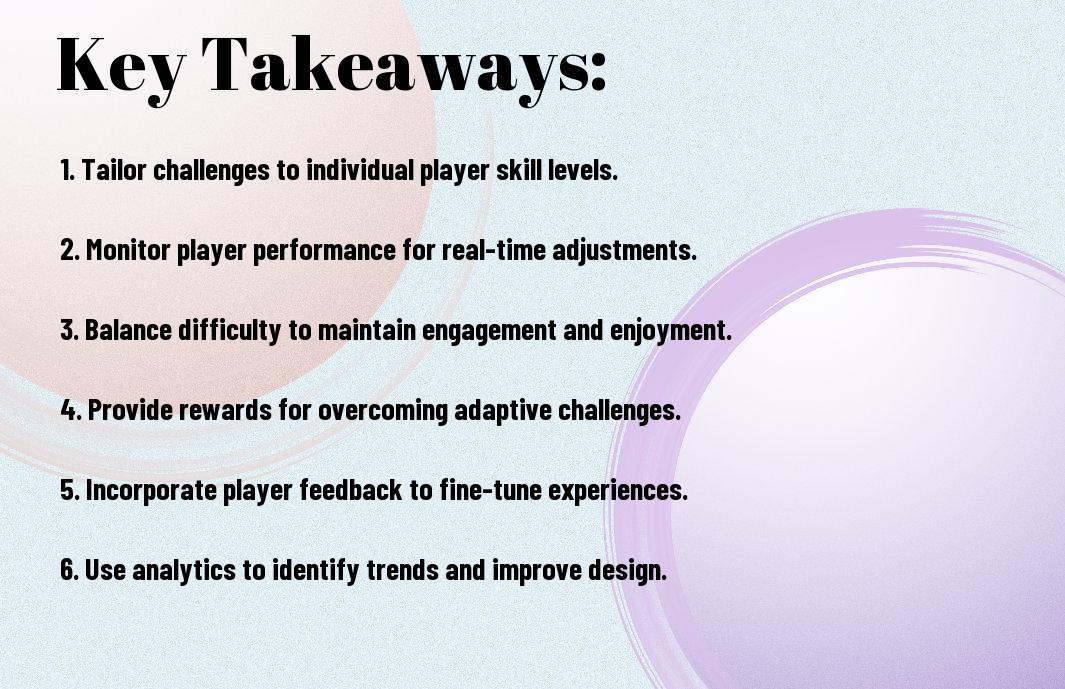As you research into the world of game design, you’ll find that keeping players engaged is a top priority. Your goal is to create an experience that challenges and rewards players, without frustrating them. Adaptive difficulty is a key component in achieving this balance, allowing you to adjust the game’s complexity in real-time, based on the player’s performance. By incorporating adaptive difficulty into your design, you can ensure that your players stay invested in the game, eager to overcome the next obstacle.
Key Takeaways:
- Adaptive difficulty systems can significantly enhance player engagement by adjusting the challenge level to match individual skill levels, providing an optimal experience for players of varying abilities.
- Implementing adaptive difficulty requires a deep understanding of player behavior, preferences, and emotional responses to different game scenarios, which can be achieved through data analysis and player feedback.
- A well-designed adaptive difficulty system can help reduce player frustration, as it ensures that challenges are neither too easy nor too hard, keeping players motivated and interested in the game.
- Adaptive difficulty can be applied to various aspects of gameplay, including enemy AI, level design, and puzzle complexity, allowing developers to create a more dynamic and responsive game world.
- Player psychology plays a significant role in adaptive difficulty design, as it’s vital to balance challenge and reward to maintain player satisfaction and emotional investment in the game.
- Adaptive difficulty systems can be used to create a sense of progression and growth, as players are presented with increasingly complex challenges that require them to develop new skills and strategies.
- Continuous testing and iteration are necessary to fine-tune adaptive difficulty systems, ensuring they effectively respond to player behavior and provide an enjoyable experience for a wide range of players.
Core Elements of Adaptive Difficulty
To create an engaging experience, you need to understand the core elements of adaptive difficulty, which involve adjusting the game’s challenge level based on your performance, ensuring that the game remains exciting and rewarding.
Player Performance Metrics
On the surface, tracking your progress and performance is crucial to adaptive difficulty, as it allows the game to assess your strengths and weaknesses, making adjustments to provide an optimal experience.
Dynamic Adjustment Systems
Between the various systems that enable adaptive difficulty, dynamic adjustment stands out, as it enables the game to modify its challenge level in real-time, based on your actions and decisions, creating a unique experience tailored to your skills.
And as you research deeper into dynamic adjustment systems, you’ll find that they can be applied to various aspects of the game, such as enemy difficulty, puzzle complexity, or even the narrative’s pacing, allowing you to enjoy a seamless and immersive experience that adapts to your preferences and abilities.

Psychological Foundations
While designing adaptive difficulty, you should consider the psychological aspects that drive player engagement. Your goal is to create an experience that adjusts to the player’s skills, keeping them invested in the game.
Flow State and Challenge Balance
Alongside the game’s progression, you need to balance challenge and skill level to maintain the player’s flow state, ensuring that the game is neither too easy nor too hard, keeping you fully engaged.
Player Motivation Patterns
For your game to be successful, you must understand what motivates your players, including their needs, desires, and expectations, allowing you to design an adaptive difficulty system that caters to their unique preferences.
It is imperative to analyze your players’ behavior, identifying patterns and tendencies that influence their motivation, such as achievement, competition, or exploration, and use this knowledge to create a tailored experience that sustains their interest and enthusiasm, making your game more enjoyable and rewarding for you.

Implementation Methods
All games can benefit from adaptive difficulty, and you can implement it in various ways to keep your players engaged. You’ll need to consider your game’s mechanics and design to choose the best approach.
Real-time Difficulty Scaling
With this method, you adjust the difficulty level based on the player’s performance in real-time, ensuring an optimal challenge. You can use algorithms to analyze the player’s progress and adjust the difficulty accordingly.
Hidden Assistance Systems
Realtime adjustments can also be made through hidden assistance systems, where you subtly aid the player without making it obvious. You can use these systems to help the player overcome difficult sections or to make the game more enjoyable.
But as you implement hidden assistance systems, you need to be careful not to make the game too easy or predictable. You want to create a sense of accomplishment and challenge for your players, while also ensuring they don’t get frustrated and give up. By striking the right balance, you can create an engaging and enjoyable experience for your players.
Player Experience Design
For a game to be truly engaging, you need to consider the player’s experience as a whole, taking into account their emotions, skills, and motivations. Your goal is to create an immersive experience that challenges and rewards players in a way that keeps them coming back for more.
Feedback Mechanisms
On the surface, feedback mechanisms may seem like a minor aspect of game design, but they play a significant role in shaping your experience. You’ll find that well-designed feedback mechanisms can make all the difference in keeping you informed and motivated throughout the game.
Progression Curves
With a well-designed progression curve, you can ensure that the game stays exciting and challenging, without becoming too frustrating or boring. You’ll want to balance difficulty and reward to keep players engaged and motivated to continue playing.
Indeed, progression curves are a delicate balance of challenge and reward, and getting it right can make all the difference in your gaming experience. As you design your game, you’ll need to consider how to pace the difficulty level, introducing new challenges and rewards at the right moment to keep players engaged and motivated, and this is where your understanding of player psychology and behavior comes into play, allowing you to craft an experience that is both enjoyable and rewarding.
Technical Framework
Unlike traditional difficulty settings, adaptive difficulty requires a sophisticated technical framework. You can explore how AI adjusts challenges to player skill levels in AI in Game Difficulty Adjustment: Adapting Challenges to Player Skill Levels to better understand the concept.
Algorithm Components
With the right algorithm components, you can create an adaptive difficulty system that adjusts to your players’ skills. Your system should include variables such as player performance, game progress, and difficulty levels to ensure a smooth experience.
Response Time Management
Between adjusting difficulty levels and player interactions, you need to manage response times effectively. Your goal is to create a seamless experience that challenges players without frustrating them.
Considering the importance of response time management, you should focus on optimizing your system’s performance to minimize delays and ensure that difficulty adjustments occur in real-time, allowing your players to fully immerse themselves in the game without interruptions or frustrations, thus enhancing their overall gaming experience.
Common Pitfalls
Not every adaptive difficulty system is created equal, and you may encounter issues that detract from your players’ experience. Your goal is to keep players engaged, but poorly designed systems can have the opposite effect.
Over-assistance Issues
Beneath the surface of a well-designed adaptive difficulty system, you’ll find a delicate balance between challenge and assistance. Below this threshold, your players may become too comfortable, leading to boredom and disengagement.
Difficulty Spikes
By introducing sudden increases in difficulty, you risk frustrating your players and causing them to abandon your game. Your adaptive system should aim to avoid these spikes, instead opting for a smoother learning curve.
In fact, difficulty spikes can be particularly damaging to your players’ experience, as they can create a sense of unfairness and make your game feel unenjoyable. You should strive to create a system that challenges your players without overwhelming them, allowing them to progress at a pace that feels rewarding and engaging.
To wrap up
Now, as you consider implementing adaptive difficulty in your game, you’ll find that it enhances your players’ experience. You can achieve this through smart design, adjusting the challenge to match your players’ skills. For more information, visit Dynamic game difficulty balancing to learn how to keep your players engaged. You’ll see that adaptive difficulty is key to creating an immersive experience, and with the right approach, you can keep your players coming back for more.
FAQ
Q: What is Adaptive Difficulty and how does it contribute to player engagement?
A: Adaptive Difficulty refers to a game design approach where the challenge level adjusts in real-time based on the player’s performance. This technique ensures that the game stays exciting and engaging by providing an optimal level of difficulty, neither too easy nor too hard. By continuously assessing the player’s skills and adapting the game’s difficulty accordingly, Adaptive Difficulty helps maintain a high level of player motivation and enjoyment, as players feel a sense of accomplishment and are encouraged to continue playing.
Q: How does Adaptive Difficulty impact the overall gaming experience, and what are its benefits for game developers?
A: Adaptive Difficulty significantly enhances the overall gaming experience by providing a tailored challenge that suits each player’s abilities. This leads to increased player satisfaction, reduced frustration, and a longer playtime. For game developers, incorporating Adaptive Difficulty into their games offers several benefits, including improved player retention, enhanced game replayability, and the ability to attract a broader audience. By leveraging player data and analytics, developers can refine their Adaptive Difficulty systems, creating a more dynamic and engaging experience that keeps players coming back for more.
Q: What techniques and technologies are used to implement Adaptive Difficulty in modern games, and how do they contribute to a more immersive experience?
A: Modern games utilize a variety of techniques and technologies to implement Adaptive Difficulty, including machine learning algorithms, player behavior analysis, and dynamic difficulty adjustment (DDA) systems. These technologies enable games to assess player performance in real-time, adjusting factors such as enemy strength, puzzle complexity, and level layout to create a challenging yet manageable experience. By leveraging these techniques, game developers can craft a more immersive experience that responds to the player’s actions, creating a sense of agency and investment in the game world. This, in turn, leads to a more engaging and enjoyable experience, as players feel that the game is tailored to their unique skills and playstyle.



